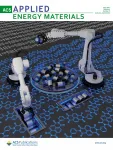(Press-News.org) Reno, Nev. (May 25, 2021) - After a wildfire, soils in burned areas often become water repellent, leading to increased erosion and flooding after rainfall events - a phenomenon that many scientists have attributed to smoke and heat-induced changes in soil chemistry. But this post-fire water repellency may also be caused by wildfire smoke in the absence of heat, according to a new paper from the Desert Research Institute (DRI) in Nevada.
In this pilot study (exploratory research that takes place before a larger-scale study), an interdisciplinary team of scientists led by DRI Associate Research Professor of Atmospheric Science Vera Samburova, Ph.D., exposed samples of clean sand to smoke from burning Jeffrey pine needles and branches in DRI's combustion chamber, then analyzed the time it took for water droplets placed on the sand surface to be absorbed - a measure of water repellency.
The pilot study investigated the effects of smoke and heat on water repellency of the sand, and was the first study to also incorporate an analysis of cold smoke. In the experiments, sand was used in place of soil because it could be cleaned thoroughly and analyzed accurately, and Jeffrey pine for a fuel source because it represents a common wildland fire fuel in the Western U.S.
Before exposure to Jeffrey pine smoke, water droplets placed on the surface of the sand samples were quickly absorbed. But after exposure to smoke, the sand samples showed severe-to-extreme water repellency, in some cases retaining water droplets on the soil surface for more than 50 minutes without soaking in. It made little difference whether or not samples had been exposed to heat and smoke, or just cold smoke.
"The classic explanation for fire-induced water repellency is that it is caused as smoke diffuses under rather hot conditions and settles down into the soils, but our work shows that the smoke does not have to be hot to turn the sand hydrophobic -- simply the presence of the chemical substances in the smoke is enough," Samburova said. "This is something we really need to look deeper into, because soil water repellency leads to increases in flooding, erosion, and surface runoff."
This study built on previously published work by former DRI postdoctoral researcher Rose Shillito, Ph.D., (currently with the U.S. Army Corps of Engineers), Markus Berli, Ph.D., of DRI, and Teamrat Ghezzehei, Ph.D., of University of California, Merced, in which the researchers developed an analytical model for relating soil water repellency to infiltration of water.
"Our earlier paper focused on how fire changes the properties of soils, from a hydrology perspective," Berli said. "In our current study, we were interested in learning more about the chemistry behind the process of how soils come to be hydrophobic. We're bringing together geochemistry and organic geochemistry with soil physics and hydrology to understand the impact of fire-induced water repellency on hydrology."
The project team is now working on a larger proposal to further investigate questions touched on by this study about the roles of heat and smoke in fire-induced water repellency. Among other things, they would like to know how long soil water repellency lasts after a fire, and gain a better understanding of the detailed processes and mechanisms through which cold smoke affects the soil.
Gaining a thorough understanding of the process that leads to fire-induced soil water repellency is important," because and managers need this information in order to accurately predict where soils are likely to be hydrophobic after a fire, Berli explained.
"We still don't really understand the processes that lead to this fire-induced soil water repellency," Berli said. "Depending on what we find, the measures to predict fire-induced water repellency might be different, and this can have a significant impact on how we can predict and prevent flooding or debris flows that happen after a fire."
"This study was one big step forward, but it highlights the importance of future research on how fires affect soil, because wildfires are affecting thousands and thousands of square kilometers of land each year in the Western U.S.," Samburova added. "Some of our future goals are to find out how exactly this soil water repellency happens, where it happens, and how long it lasts."
INFORMATION:
More information:
This study was made possible with support from DRI and the National Science Foundation. Study authors included Vera Samburova, Ph.D., Rose Shillito, Ph.D. (U.S. Army Corps of Engineers), Markus Berli, Ph.D., Andrey Khlystov, Ph.D., and Hans Moosmüller, Ph.D., all from DRI.
The full text of the paper, Effect of Biomass-Burning Emissions on Soil Water Repellency: A Pilot Laboratory Study, is available from Fire: https://www.mdpi.com/2571-6255/4/2/24
About the Desert Research Institute
The Desert Research Institute (DRI) is a recognized world leader in basic and applied interdisciplinary research. Committed to scientific excellence and integrity, DRI faculty, students, and staff have developed scientific knowledge and innovative technologies in research projects around the globe. Since 1959, DRI's research has advanced scientific knowledge, supported Nevada's diversifying economy, provided science-based educational opportunities, and informed policymakers, business leaders, and community members. With campuses in Reno and Las Vegas, DRI serves as the non-profit research arm of the Nevada System of Higher Education. For more information, please visit http://www.dri.edu.
Cells are the building blocks of life, present in every living organism. But how similar do you think your cells are to a mouse? A fish? A worm?
Comparing cell types in different species across the tree of life can help biologists understand how cell types arose and how they have adapted to the functional needs of different life forms. This has been of increasing interest to evolutionary biologists in recent years because new technology now allows sequencing and identifying all cells throughout whole organisms. "There's essentially a wave in the scientific community to classify all types of cells in a wide variety of different organisms," explained Bo Wang, an assistant professor of bioengineering at Stanford University.
In response to this opportunity, ...
A new study finds that fly ash--particles left over from burning coal--make up between 37 and 72 percent of all particulate organic carbon carried by the Yangtze River in China, or around 200,000 to 400,000 tons of carbon per year.
The study, which is the first of its kind, shows just how big an impact fossil fuel consumption has on Earth. Beyond pumping carbon dioxide into the atmosphere, coal burning dumps about as much particulate carbon into the Yangtze River as natural processes do.
The findings were published in the Proceedings of the National Academy of Sciences (PNAS) on May 17.
"About one-fifth of the world's coal consumption occurs along this river," says Gen Li, postdoctoral ...
A new report by Skoltech scientists and their colleagues describes an organic material for the new generation of energy storage devices, which structure follows an elegant molecular design principle. It has recently been published in ACS Applied Energy Materials and made the cover of the journal.
While the modern world relies on energy storage devices more and more heavily, it is becoming increasingly important to implement sustainable battery technologies that are friendlier to the environment, are easy to dispose, rely on abundant elements only, and are cheap. Organic batteries are desirable ...
East Hanover, NJ. May 25, 2021. A team of experts in post-stroke neurorehabilitation confirmed that including prism adaptation treatment in standard of care for patients with post-stroke spatial neglect improved functional and cognitive outcomes according to the Functional Independence Measure®. The article, "Prism Adaptation Treatment Improves Inpatient Rehabilitation Outcome in Individuals with Spatial Neglect: A Retrospective Matched Control Study" (doi: 10.1016/j.arrct.2021.100130.
was published in Archives of Rehabilitation Research and Clinical Translation on May XX, 2021. It is available open access at https://www.sciencedirect.com/science/article/pii/S2590109521000343
The ...
LED lightbulbs offer considerable advantages over other types of lighting. Being more efficient, they require much less electricity to operate. They do not give off unwanted heat the way old-school incandescent bulbs do, and the best of them long outlast even fluorescent lightbulbs.
But LEDs are not problem-free. Questions linger over suspected links between health concerns such as fatigue, mood disorders, and insomnia from overexposure to the blue-tinted light produced by today's standard LED bulbs. Plus, higher prices can prompt lightbulb shoppers to weigh other options.
A University of Houston research team led by Jakoah Brgoch, associate professor of chemistry in the College of Natural Sciences and Mathematics and principal investigator in the Texas Center for ...
ITHACA, N.Y. - It stands to reason that the more one is compensated for performing a task, the greater the incentive to do a good job and the better one feels about doing it.
But what if the task is writing an objective review of a company or service? Does the compensation blur the lines of objectivity?
Kaitlin Woolley, assistant professor of marketing in the Samuel Curtis Johnson Graduate School of Management, Cornell SC Johnson College of Business, wondered the same thing.
"You often receive emails after a purchase, offering you a chance to win a gift card to the company in ...
One in five women experience pain during intercourse. The latest edition of the Diagnostic and Statistical Manual of Mental Disorders, the bible of American psychiatrists, lists it under "genito-pelvic pain or penetration disorder." However, this type of pain is not purely psychological.
Provoked vestibulodynia is a condition experienced by approximately 8% of women in North America. It is characterized by severe pain at the vaginal opening during sexual intercourse or when inserting tampons. To reduce the burning sensation, many women apply lidocaine, an anesthetic ...
Boston, MA-- How does the switch to a high-deductible health plan affect children with asthma? A new study led by researchers at the Harvard Pilgrim Health Care Institute suggests that enrollment in a high-deductible health plan (HDHP) may not be associated with changes in asthma medication use or asthma exacerbations when medications are exempt from the deductible. The findings were published in JAMA Pediatrics on May 10.
To treat asthma, clinical guidelines recommend the use of controller medications, but adherence to these medications is generally suboptimal, putting those affected at risk for asthma exacerbations. High out-of-pocket costs have been associated with decreased controller medication use and adverse asthma outcomes for children and adults. ...
The energy available from sunlight is 10,000 times more than what is needed to supply the world's energy demands. Sunlight has two main properties that are useful in the design of renewable energy systems. The first is the amount power falling on a fixed area, like the ground or a person's roof. This quantity varies with the time of day and the season. The second property is the colors or spectrum of the sunlight.
One way to capture solar energy is to use solar cells that directly turn sunlight into electricity. In a solar module like those that people place on their roof, many cells are assembled on a rigid panel, connected to one another, sealed, and covered ...
New research from the Clemson University Center for Human Genetics has identified specific cell clusters in the brain of the common fruit fly affected by acute cocaine exposure, potentially laying the groundwork for the development of drugs to treat or prevent addiction in humans.
While cocaine's neurological effects are well known, the underlying genetic sensitivity to the drug's effects is not. In human populations, susceptibility to the effects of cocaine varies due to both environmental and genetic factors, making it challenging to study. Approximately 70 percent of genes in the fruit fly, Drosophila melanogaster, have human counterparts, providing researchers with a comparable model when studying ...




